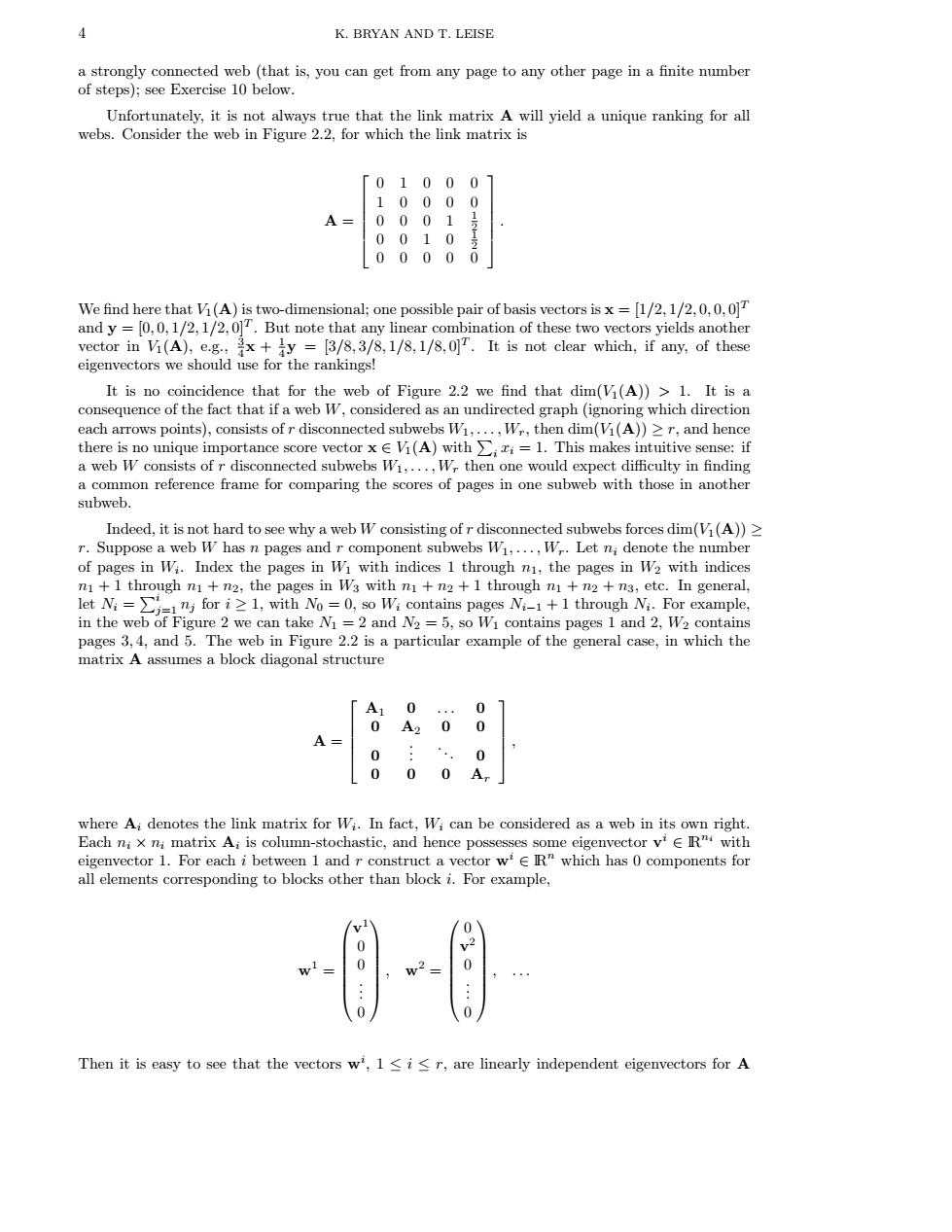正在加载图片...

4 K.BRYAN AND T.LEISE a strongly connected web(that is,you can get from any page to any other page in a finite number of steps);see Exercise 10 below. Unfortunately,it is not always true that the link matrix A will yield a unique ranking for all webs.Consider the web in Figure 2.2,for which the link matrix is 「01000 10000 0001 0 010 00000 We find here that Vi(A)is two-dimensional;one possible pair of basis vectors isx=[1/2,1/2,0,0,0]T and y=[0,0,1/2,1/2,0]T.But note that any linear combination of these two vectors yields another vector in Vi(A),e.g.,x+iy =[3/8,3/8,1/8,1/8,0]T.It is not clear which,if any,of these eigenvectors we should use for the rankings! It is no coincidence that for the web of Figure 2.2 we find that dim(V(A))>1.It is a consequence of the fact that if a web W,considered as an undirected graph(ignoring which direction each arrows points),consists of r disconnected subwebs Wi,...,Wr,then dim(Vi(A))>r,and hence there is no unique importance score vector xE Vi(A)with >zi=1.This makes intuitive sense:if a web W consists of r disconnected subwebs Wi,...,Wr then one would expect difficulty in finding a common reference frame for comparing the scores of pages in one subweb with those in another subweb. Indeed,it is not hard to see why a web W consisting of r disconnected subwebs forces dim(Vi(A))> r.Suppose a web W has n pages and r component subwebs W1,...,W.Let ni denote the number of pages in Wi.Index the pages in Wi with indices 1 through ni,the pages in W2 with indices n1+1 through n1+n2,the pages in W3 with ni+n2 +1 through n+n2 +n3,etc.In general, let Nnj for i1,with No-0,so Wi contains pages N-1+1 through N.For example, in the web of Figure 2 we can take N=2 and N2=5,so Wi contains pages 1 and 2,W2 contains pages 3,4,and 5.The web in Figure 2.2 is a particular example of the general case,in which the matrix A assumes a block diagonal structure A1 0 0 0 A2 0 A 0 0 00 where Ai denotes the link matrix for Wi.In fact,Wi can be considered as a web in its own right. Each nix ni matrix Ai is column-stochastic,and hence possesses some eigenvector vi ER"with eigenvector 1.For each i between 1 and r construct a vector wiR"which has 0 components for all elements corresponding to blocks other than block i.For example, 0 0 v2 0 0 0 0 Then it is easy to see that the vectors w,1 <i<r,are linearly independent eigenvectors for A4 K. BRYAN AND T. LEISE a strongly connected web (that is, you can get from any page to any other page in a finite number of steps); see Exercise 10 below. Unfortunately, it is not always true that the link matrix A will yield a unique ranking for all webs. Consider the web in Figure 2.2, for which the link matrix is A = 0 1 0 0 0 1 0 0 0 0 0 0 0 1 1 2 0 0 1 0 1 2 0 0 0 0 0 . We find here that V1(A) is two-dimensional; one possible pair of basis vectors is x = [1/2, 1/2, 0, 0, 0]T and y = [0, 0, 1/2, 1/2, 0]T . But note that any linear combination of these two vectors yields another vector in V1(A), e.g., 3 4 x + 1 4 y = [3/8, 3/8, 1/8, 1/8, 0]T . It is not clear which, if any, of these eigenvectors we should use for the rankings! It is no coincidence that for the web of Figure 2.2 we find that dim(V1(A)) > 1. It is a consequence of the fact that if a web W, considered as an undirected graph (ignoring which direction each arrows points), consists of r disconnected subwebs W1, . . . , Wr, then dim(V1(A)) ≥ r, and hence there is no unique importance score vector x ∈ V1(A) with P i xi = 1. This makes intuitive sense: if a web W consists of r disconnected subwebs W1, . . . , Wr then one would expect difficulty in finding a common reference frame for comparing the scores of pages in one subweb with those in another subweb. Indeed, it is not hard to see why a web W consisting of r disconnected subwebs forces dim(V1(A)) ≥ r. Suppose a web W has n pages and r component subwebs W1, . . . , Wr. Let ni denote the number of pages in Wi . Index the pages in W1 with indices 1 through n1, the pages in W2 with indices n1 + 1 through n1 + n2, the pages in W3 with n1 + n2 + 1 through n1 + n2 + n3, etc. In general, let Ni = Pi j=1 nj for i ≥ 1, with N0 = 0, so Wi contains pages Ni−1 + 1 through Ni . For example, in the web of Figure 2 we can take N1 = 2 and N2 = 5, so W1 contains pages 1 and 2, W2 contains pages 3, 4, and 5. The web in Figure 2.2 is a particular example of the general case, in which the matrix A assumes a block diagonal structure A = A1 0 . . . 0 0 A2 0 0 0 . . . . . . 0 0 0 0 Ar , where Ai denotes the link matrix for Wi . In fact, Wi can be considered as a web in its own right. Each ni × ni matrix Ai is column-stochastic, and hence possesses some eigenvector v i ∈ lRni with eigenvector 1. For each i between 1 and r construct a vector wi ∈ lRn which has 0 components for all elements corresponding to blocks other than block i. For example, w1 = v 1 0 0 . . . 0 , w2 = 0 v 2 0 . . . 0 , . . . Then it is easy to see that the vectors wi , 1 ≤ i ≤ r, are linearly independent eigenvectors for A